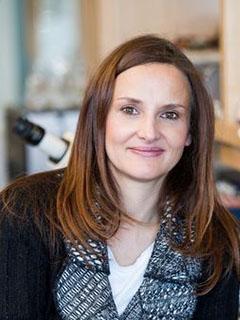 Sandra Rieger
Sandra Rieger
ASSOCIATE PROFESSOR
Office/Lab: 226/ 204
Cox Science Center Neuroscience Annex
1301 Memorial Drive, Coral Gables, FL 33146
E-mail: srieger@miami.edu
Office Phone: (305) 284-9935
Lab Phone: (305) 284-9478
EDUCATION AND PROFESSIONAL EXPERIENCE
Associate Professor, 2018 – present, Biology Department, University of Miami
Assistant Professor, 2011 – 2018, Kathryn W. Davis Center for Regenerative Biology, MDI Biological Laboratory
Postdoctoral Fellow, 2007 – 2011, Department of Molecular, Cell and Developmental Biology, University of California, Los Angeles
Ph.D. in Developmental Neurobiology, 2008 Technical University Munich, Germany
Graduate work, 2004 – 2007, Helmholtz Center Munich, Germany
B.S./M Sc. (German Diploma), 2002, Germany
Bachelor thesis. R&D Department, Zyomyx Inc., Hayward CA, 2002
GRANTS AND AWARDS
- 2018 – 2019 CTSI Pilot Award, University of Miami School of Medicine (Principal Investigator)
- 2017 – 2022 1R01CA215973 NCI/ NIH (Principal Investigator)
- 2017 – 2018 SG5598 Maine Technology Institute (Principal Investigator)
- 2016 – 2017 R21 NS094939 NIH/NINDS (Principal Investigator) (relinquished)
- 2016 Young Investigator Travel Award, National IDeA Symposium of Biomedical Research Excellence (NISBRE)
- 2013 – 2017 P20GM104318 NIH/NIGMS (Project leader)
- 2011 UCLA Chancellor’s Award for Postdoctoral Research Nominee
- 2011 – 2013 P20GM103423 NIH/NIGMS (Project leader)
- 2009 Grass Fellowship Award from the Albert and Ellen Grass Foundation
- 2012 – 2014 12GHSU179 NIH-NIDDK DiaComp (Principal Investigator)
- 2004 MBL Scholarship, Marine Biology Laboratories, Woods Hole
- 2003 Outstanding Scientific Diploma Research and Thesis Award, European Allergy Association e.V. (AVE e.V.)
AREAS OF FOCUS
Regenerative Biology, Wound healing & Peripheral Neuropathy
RESEARCH INTERESTS
How sensory nerve endings in the skin interact with skin cells, such as epidermal keratinocytes, is a fundamentally understudied research area. This knowledge is however highly important as these interactions promote wound repair and limb regeneration, and their perturbations are known to lead to disease conditions like peripheral neuropathy. The Rieger lab is working on several questions with regard to axon-keratinocyte interactions:
- What type of interactions exist between somatosensory neurons and epidermal keratinocytes following tissue injury?
- What molecular processes promote their crosstalk?
- How are these molecular processes perturbed under disease conditions?
- Can we manipulate certain molecular pathways in neurons or keratinocytes to develop treatments for degenerative conditions leading to peripheral sensory axon degeneration (a type of peripheral neuropathy) and wound healing or appendage regeneration defects?
We are using zebrafish as a model system to characterize sensory neuron-keratinocyte interactions in vivo, and we have recently begun to also investigate rodent models for comparative purposes. We focus primarily on mechanisms involving hydrogen peroxide (H2O2) signaling, as we identified this molecule to be a key mediator of the crosstalk between sensory neurons and keratinocytes following injury. We discovered that H2O2 generated in wound keratinocytes promotes sensory axon regeneration (Rieger & Sagasti, PLoS Biology 2011). We also found evidence that hormetic concentrations of H2O2 are critical for proper wound repair. If the concentrations are too high, H2O2 can damage keratinocytes and induce wound healing defects. Similarly, we identified that high concentrations of H2O2 are induced in keratinocytes during treatment with the chemotherapeutic agent paclitaxel, leading to upregulation of the matrix-degrading metalloproteinase, MMP-13, in keratinocytes. Increased MMP-13 activity correlates with epidermal damage and sensory axon degeneration (Lisse et al., PNAS 2016).
We have completed several studies to characterize the role of H2O2 in wound repair and are currently identifying H2O2-dependent molecular processes leading to sensory axon regeneration. We have also established zebrafish in vivo models with which to study the crosstalk between sensory neurons and keratinocytes under conditions of paclitaxel and glucose (diabetes) treatment.
Another project relates to the question how sensory nerve endings interact with wound epidermis following limb amputation. We are particularly interested in the role of Anterior Gradient Protein in this process, which has been shown to function in a nerve-dependent manner during newt limb regeneration. We are currently exploring the role of one family member of the Anterior Gradient Protein family in this process.
TEACHING INTERESTS
In my classes I try to convey the scientific knowledge that I have gained over the years to the students in such a manner that they will be prepared for a scientific career and all the challenges that they might encounter. I also try to teach students critical thinking abilities and encourage them not to take everything for granted. I am currently teaching Developmental Neurobiology at the University of Miami. In the past, I have designed and taught several week-long laboratory courses in Regenerative Biology using zebrafish as a model.
Another important aspect for me is to communicate my research to the general public, which is becoming more critical as the public’s interest in science is rising. A study showed that only 30 percent of Americans believe that scientists efficiently convey their research findings to non-scientists. To do public outreach, I have presented my work to non-scientists in retirement communities, to government officials including the Maine senator Angus King, artists, and general Kindergarten students, and citizens interested in my work. I have also spoken about my work at the Maine Public Broadcasting Network radio (MPBN), online platforms and blogs, local newspapers, TV (Fox22), and online portals such as The Peripheral Neuropathy Foundation Newsletter and other peripheral neuropathy blogs, demonstrating the interest of the public in my work.
SELECTED PUBLICATIONS
Book chapters
Grover H & Rieger S: ROS and neuroepithelial interactions during wound healing, Chapter 2 in book “Regenerative Engineering and Developmental Biology: Principles and Applications”, CRC Press Taylor & Francis Group. (2017)
Zhang H, Pullagura S, Rieger S, Lisse TS. Vitamin D and microRNAs. In book: Vitamin D, 4rd edited by David, J. Wesley Pike, M. Hewison (2017)
https://scholar.google.com/citations?hl=en&user=WwxdXeAAAAAJ&view_op=list_works&sortby=pubdate



 Sandra Rieger
Sandra Rieger